Mossy Oak Pros 40-year-old Krissy Knox of Halsey, Oregon, and her 38-year-old brother, Ryan Hay, of Venata, Oregon, started hunting together with their grandpa, their dad and their uncle as soon as they could walk.
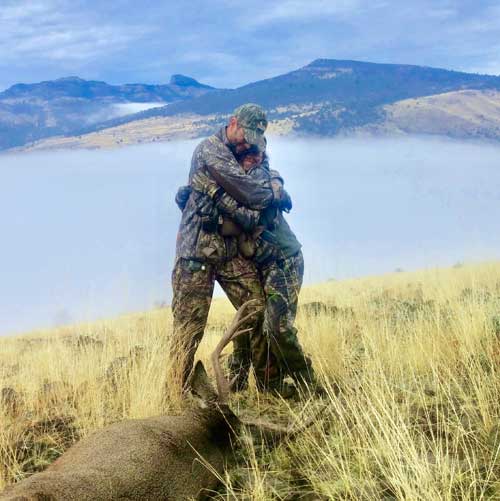 “Ever since we were old enough to draw tags, Krissy and I have hunted together,” Ryan Hay says. “I know siblings hunting together is rare, but we both are very passionate about our hunting. We grew up together. We’ve gotten along so well over the years and really never have found anyone else as passionate about hunting or who gets along as well as we do.”
“Ever since we were old enough to draw tags, Krissy and I have hunted together,” Ryan Hay says. “I know siblings hunting together is rare, but we both are very passionate about our hunting. We grew up together. We’ve gotten along so well over the years and really never have found anyone else as passionate about hunting or who gets along as well as we do.”
Taking a Trophy Mule Deer May Require Two Hunters
“Drawing a late-season tag for mule deer in Oregon is very difficult,” Krissy Knox explains. “Generally, you’ll have to apply for about 13 years to draw that late-season tag. However, Ryan and I do hunt early season for mule deer every year and usually hunt late-season black-tailed deer. Fortunately we both drew late-season archery-only mule-deer tags in 2017. We had a great hunt, and we both punched our tags. Where we were hunting late-season mule deer was on a section of the Oregon Trail. We could see the wagon ruts – some 8-inches deep - on the trail that was cut into the bedrock.”
Ryan says that, “The 2017 late-season mule-deer hunt is the first time I’ve ever been able to hunt mule deer in the rut. Our late season in Oregon is the last 12 days of November. Generally, our area has about a foot of snow by then, but on this 2017 mule-deer hunt in the late season, we only had a small amount of snow. “
“Ryan and I hunted the same mule-deer buck for the first five days of our 2017 late-season hunt,” Krissy remembers. “By the end of the season, older-class bucks know just about everything they need to know to survive.”
Ryan mentions, “We went out to the place we wanted to hunt a day early to do some scouting before the hunt began. We found the mule-deer buck we eventually hunted on the first day of scouting, and I finally took him five days later. He was on a ridge and had 8-10 does with him. Since this buck was in some open terrain, we felt our best strategy was for one of us to get on the uphill side of the buck, and the other person to get on the downhill side. Because we both were bowhunting, we realized we had to get the buck in close to take him. We’d drive along an old woods road and spot the 4X4 buck we were hunting about 500-1,000 yards away on the side of the mountain. Since other hunters used this same road to get to where they wanted to hunt, we realized that if we didn’t continue to hunt the big 4X4, the others would.”
“Although we decided to hunt this buck, other bucks would come into an area where we were hunting during that 5-day hunt to try to breed one of the does in this buck’s harem,” Ryan reports. “We went after some of those other bucks when we had an opportunity, but we didn’t stray far from the buck we had located on the first day. This buck we were hunting had a big body and really pretty 4X4 chocolate-colored antlers. Where we hunted, we did see bigger bucks than the one we were hunting, but this buck had everything we were looking for in a trophy mule deer. We always drove to the spot where we wanted to hunt before daylight each day. The other tag holders were respectful when they saw us glassing the buck and would drive on past us. We knew that if we didn’t stay on this buck, then if we came to that same spot the next morning, another hunter already would be there, and we wouldn’t have a chance to continue to hunt that buck.”
As Krissy says, “I wish we visually could show you where this mule-deer buck was holding on an open hillside in brush that wasn’t more than 18-inches high with only a few terrain breaks to hide behind and even fewer juniper trees we could use to get behind to keep the buck from spotting us.”
How the Hunting Philosophy of Ryan Hay and Krissy Knox Affected Their Mule Deer Hunt
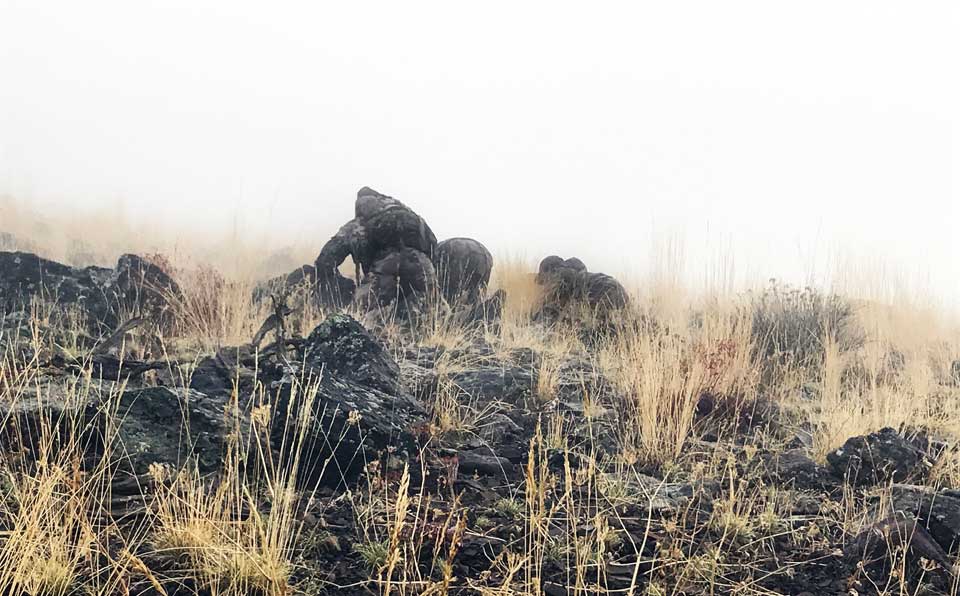
“When you start stalking in Oregon where we hunt, often you’ll find there’s more terrain breaks than you’ve initially seen when you’ve first glassed the ridge,” Ryan Hay mentions. “We discovered a small draw where we could get within 1500-2000 yards of the 4X4 mule-deer buck we were hunting, but well out of range for our bows. The buck was bedded-down with his does, and they all seemed to be fairly content.”
Krissy explains that, “When most bowhunters hunt together, usually there’s an agreement on who will take the first shot, or who will hunt a particular buck. But with Ryan and me, that’s never an issue. Actually, like many brothers and sisters, there’s always an argument. However, Ryan and I argue about, ‘You take the first shot,’ or, ‘You go after that buck.’ Then I’ll say, ‘No, Ryan. I want to see you take him.’ We both want to see our sibling be successful, rather than personally taking the buck.
“Once we spot a buck, I’ll be trying to get Ryan to shoot the buck, whereas, he’s attempting to get me to shoot the mule deer. On this particular mule-deer hunt, we weren’t always hunting together. We didn’t know which way the buck would move. The objective of our hunt was to take this mule-deer buck. Since we weren’t sure of which way the buck and his does would move, when the wind was right, one of us would get on one side of the buck with the other shooter on the other side of the buck. So, hopefully one of us would take him.”
Ryan says that, “Something else that was strange about this 4X4 mule-deer buck and his does was apparently they’d lived on this hillside for some time. Human odor didn’t seem to bother them very much. Several times I was upwind of the herd, and even though the mule deer could smell me but not see me, they didn’t seem to be disturbed. I believe that because this terrain was so open the mule deer realized that if they couldn’t see a hunter that there was no danger close enough to them that should cause them to flee. That’s what enabled us to stay parallel on both sides of the buck at the same elevation where he was holding.
“Only 20 bowhunters drew tags to hunt late-season mule deer in this region. Up until 1970, the west side of this huge unit was only open for bowhunting in the late season. However, in 2017, Oregon’s Department of Fish and Wildlife opened up the east side as well as the west side of the unit for late-season mule-deer bowhunting. I think since this new section of the unit opened up, this area was where most tag holders hunted mule deer. During our hunt, we saw at least 10 of the 20 bowhunters with tags using the same road we did to reach the places where they hunted. Due to this unit’s covering several counties, there was plenty of room for everyone to hunt.
“We knew there was no way we could approach this big 4X4 mule deer where he was bedded. We decided to go back to the road, get in our vehicle, drive to the end of the ridge and then hike along the top of the ridge to stalk the buck from above. Moving down the top of the ridge, I spotted a nice 4-pointer with a doe, shot at him and missed. As we stalked down the back side of this ridge, we bumped into several more mule-deer bucks and attempted to get around them without spooking them. Our plan was to come over the top of the ridge and see if we couldn’t stalk down to the big buck with his does. I’d used the onX program on my phone to mark exactly where the buck was bedded. I also could see the track we were taking to him. Then we’d know where to come up over the top of the ridge and plan our stalk accordingly.”
The Best Tool for Navigating New Territory and Planning a Mule Deer Stalk
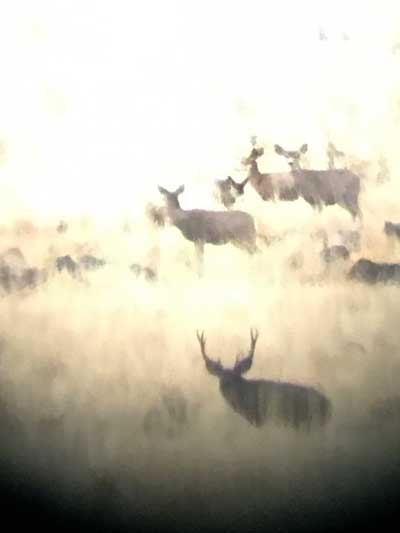 “We use the onX software on our cell phones when we’re hunting mule deer or black-tailed deer,” Ryan emphasizes. “We download the onX software to our phones, which makes our phones hand-held GPS units. Often in places where we hunt, we don’t get good cell service reception. However, if you add the onX maps of the places where you plan to hunt and store them in your phone’s memory, then even if you don’t have cell service, you can pull up the onX maps you’ve saved and get all the advantages of a GPS receiver with those maps. The advantage of using these onX maps is that even without cell service, you can mark waypoints and track the route you’re taking on that map to reach the waypoint where you want to go.
“We use the onX software on our cell phones when we’re hunting mule deer or black-tailed deer,” Ryan emphasizes. “We download the onX software to our phones, which makes our phones hand-held GPS units. Often in places where we hunt, we don’t get good cell service reception. However, if you add the onX maps of the places where you plan to hunt and store them in your phone’s memory, then even if you don’t have cell service, you can pull up the onX maps you’ve saved and get all the advantages of a GPS receiver with those maps. The advantage of using these onX maps is that even without cell service, you can mark waypoints and track the route you’re taking on that map to reach the waypoint where you want to go.
“What we use the onX maps for most of the time is to get the satellite image and the topography of that land where we’re hunting. So, on our late-season mule-deer hunt, I went to the onX map of the hillside where the buck was staying, spotted a group of trees just above where those mule deer were bedded down and then determined a route for Krissy and I to get as close as possible without being seen by the buck and his does. At the end of the first day, when we came over the ridge, the buck and his does had moved and gone closer to the top of the ridge where we were. But the herd never got closer than 120 yards to us. We backed out. We didn’t want to spook them. We returned the way we had come and planned to hunt this same 4X4 buck the next morning.”
According to Krissy, “On the next day, I decided to hunt a big 3-pointer I’d spotted up on the ridge and let Ryan go after the 4X4 trophy mule-deer buck with his does. Because the 3-point mule deer was holding in some wide-open terrain, and I had no cover to reach the buck, I decided to lay on my stomach and crawl as close to the buck as possible. I’d only put my head up about every 20-30 yards to make sure I was crawling in the right direction to get nearer to the 3-pointer. When I was 80 yards from the buck, I raised my head up to check my course, and a doe stood up not 20 yards from me and spooked the 3-pointer.”
“I found the big 4X4 that morning and was able to get to within 200 yards of him and his does,” Ryan reports. “They were feeding up the hill, and one of the 10 does with him stayed well behind the others. At one point, the buck decided to come back and pick up the doe that was lagging behind the rest of his harem. I was above the group of 9 does that were left, and I stayed behind a tree. Once the buck turned his back on me and those does, I stepped out from behind a tree and deliberately spooked the 9 does left. Then just the 4X4 buck and the doe would be isolated, and hopefully I’d increase my odds for taking the buck.
“The buck started nosing that one doe to get her up and move her to the top of the ridge where the other does had gone. I remained on my stand for another 45 minutes to make sure that the 4X4 wasn’t going to pop out of that cover on top of the ridge. When the buck didn’t, I felt that he must have bedded-down with that one doe. I closed the distance to the 4X4 buck by moving slowly and cautiously toward him, using every tree I could to keep him from seeing me. Then I reached a point where I had some cover and was where the buck had gone into the cover on top of the ridge. Finally the doe with the buck stood up, about 50 yards from me and looked at me.
“Next the buck quickly stood up and walked out of the cover, right behind the doe that then turned to go back the way that she and the buck had come up the mountain. I saw a small opening and ranged the distance to it at 60 yards. The doe came through the opening, and I then came to full draw. Once the buck stepped into the opening, he stopped, and I released my arrow but shot over the buck’s back. The 4X4 buck and the doe trotted off. They weren’t terrified though and started feeding again. I knew where Krissy was and realized the buck was headed to her. I called her on my cell phone and texted her, knowing we only had about 45 minutes to an hour of daylight left.”
“Realizing that I needed to return to our vehicle before dark, I already had started down the mountain when Ryan texted me,” Krissy remembers. “I only had one tiny juniper tree I could get next to when I heard from Ryan. I just had to pray that the 4X4 buck would come close to the juniper tree, and that I could get a shot at him. The buck and the doe came out of the cover about 70 yards from me, but I didn’t have a shot.”
How Krissy Knox and Ryan Hay Hunted Oregon Trail Mule Deer
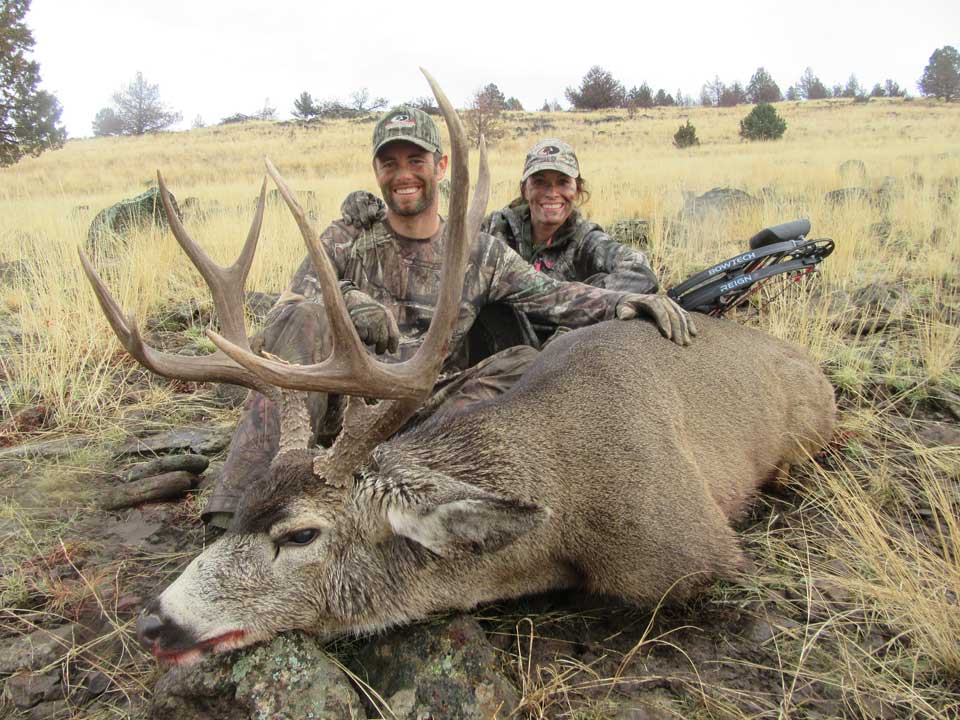
On day three of Krissy and Ryan’s late-season mule-deer hunt, they spotted the 4X4 buck once more.
“Krissy and the buck were to the north of me,” Ryan reports. “The buck was about midway up the mountain. I stalked up the same drainage that Krissy and I had stalked up the first morning we spotted him. That drainage petered out about midway of the mountain. The buck and one doe were feeding across the mountain toward me and then bedded in a small drainage right across the mountain from me. The buck and the doe were walking away from Krissy but right to me. I snuck around and got above the doe and the buck in the drainage where they had bedded. I finally reached a place about 50 yards above the buck and the doe and then decided that my best strategy was to stay put. However, after 3 hours of my legs being bent up under me and suffering from fanny fatigue, I decided to crawl on my belly to see if the buck still was at the same place, or if he had snuck out and gone away from me.
“After only going a short distance, I saw the doe about 40 yards from me, and the 4X4 buck only about a yard behind her tail, following the doe up the mountain. Once I came to full draw, the doe spotted me and trotted off, as the buck walked fast behind her. When the buck was 38 yards away, I grunted, I whistled, and I did everything I could do to stop that buck. I realized that the first time I shot at this big 4X4 mule deer I overestimated the distance, so this time I apparently underestimated the distance and shot at 50 yards with my arrow hitting right under the buck that was at 60 yards away.
“Then on the fourth day, I had another encounter with the 4X4 buck. He came down the mountain and bedded-down about 60 yards from me, with the doe bedding about 50 yards below me. I thought when the buck stood up, he’d probably come down the mountain toward his doe. I should have an easy shot. But when the buck stood up, he turned around and walked directly away from me.”
The Mule Deer Hunt’s Final Days
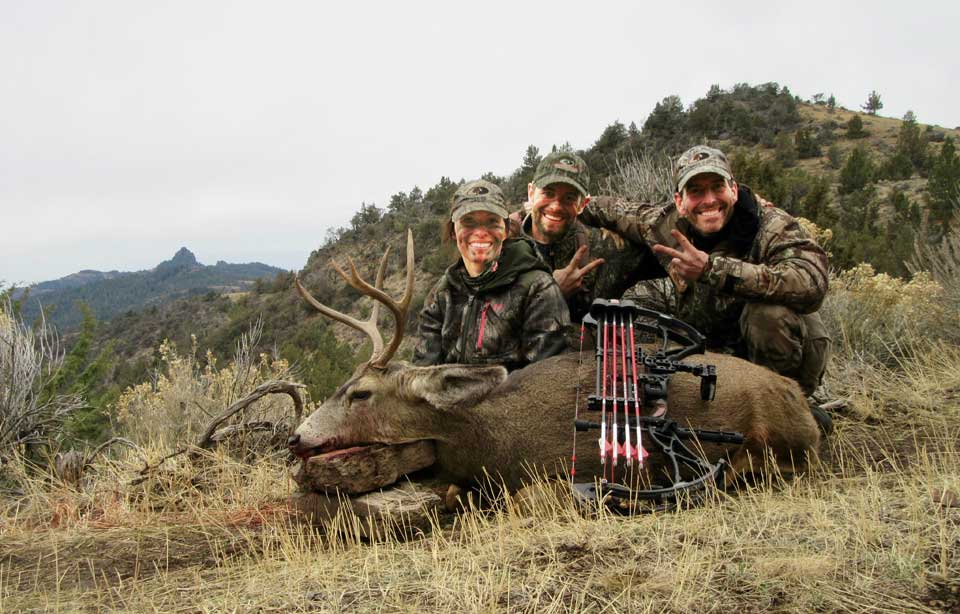
Krissy recalls, “On the 5th day of the hunt, the 4X4 buck left his does and walked parallel to the road, across the side of the mountain. We were 1/4-mile below him when we spotted him. We realized we had to get up to him quickly, if we were to get a shot. Ryan and I started running together up the mountain. Ryan’s like a mountain goat, so I had to use all my energy and strength to keep up with him. Finally I realized that Ryan could reach that 4X4 buck faster than I could, so I told him to go ahead and try to cut the buck off. ‘I’ll get there when I can Ryan.’
“I watched Ryan draw closer to the buck, and the buck was coming to him. Ryan was 30 yards away from the mule-deer buck, but he couldn’t see the buck, since the buck was in the other draw next to the draw where we were. Because I was behind Ryan and somewhat higher in the draw where we were, I spotted the buck before Ryan did. I had time to range the 4X4 at 60 yards, came to full draw and shot over his back. When Ryan saw me shoot, he knew I was shooting at the big buck. Ryan got ready to take a shot. Once my arrow passed over the buck’s back, the buck turned away from me and right toward Ryan. So, I think I got the assist on Ryan taking that 4X4 buck we’d been chasing during the entire hunt.”
According to Ryan, “As soon as I saw and heard Krissy shoot, I spotted the buck’s antlers and ranged him at 60 yards. Since I shoot a single-pin sight, I set my pin on 60 yards. Once the buck took two more steps, I grunted, and the buck stopped and turned broadside to me. I put my 60-yard pin on the buck’s front shoulder and released my arrow. Once the broadhead hit the buck, it broke his front shoulder and went into his chest cavity, hitting the offside lung. He then ran a small distance before bedding-down in the open. Next he got up, went about 30 yards more and bedded-down again before getting up and walking into a small drainage. Then fog rolled in, and our family and friends watching the hunt unfold couldn’t tell us anything about the buck, due to the thick fog. Krissy and I decided to pull out, go down to the road where we should be able to see him better and wait on the fog to lift before we went after him. When we finally got to within 5 yards of the 4X4, I put another arrow in him. The buck scored in the low 150s on Pope & Young.”
“We spent a lot of time celebrating Ryan’s successful hunt,” Krissy reports. “By the time we got the mule deer down the mountain, dark almost had fallen. I still had a tag, and although I’d spotted another mule-deer buck, I couldn’t get close enough to take a shot. We loaded up Ryan’s 4X4 buck and drove out of the mountain, spotting the 3-prong buck we’d seen earlier and decided to go after him the following morning.
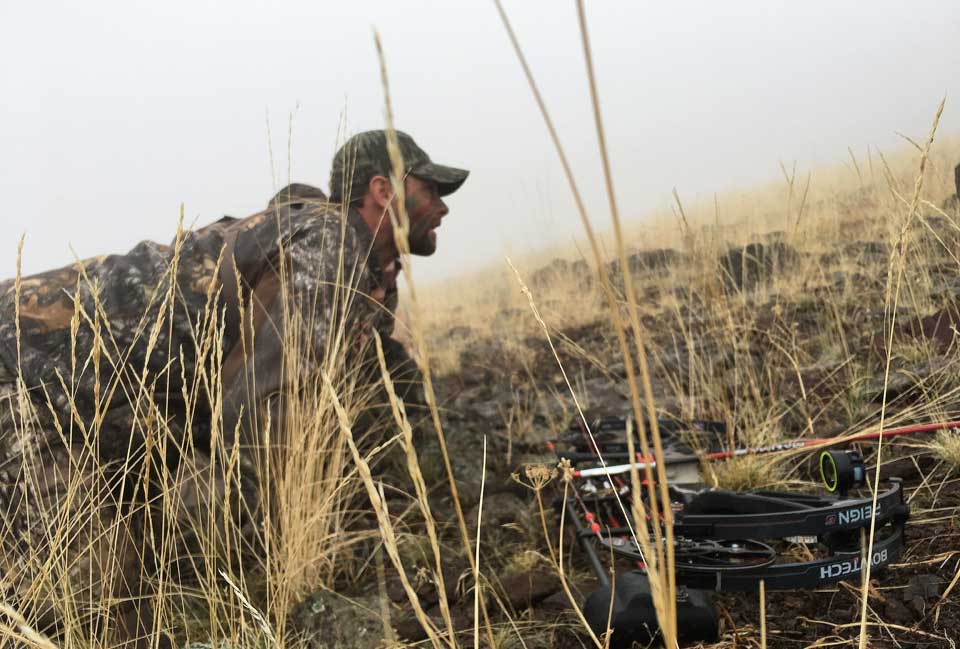
“The next morning, our 6th day of hunting, Ryan whispered on my GPS radio, ‘I don’t know how you did it, but that 3-pointer and three other mule-deer bucks are right below you and feeding, coming to you.’ Ryan had stayed behind on the road and was watching my hunt progress through the spotting scope. My boyfriend Stacy Locks was with me. I didn’t have time to use my range finder but estimated the buck was at about 23 yards. Once I released my arrow, I heard it tick a limb, and my arrow flew over the 3-point buck’s back. I was very discouraged. I only had one more day to hunt, and although I was happy and excited for Ryan and the buck he took, I was disappointed I didn’t get a mule-deer buck after waiting 13 years to draw this hunt. That day I’d spent about 8 hours crawling on my belly and then didn’t make the shot. At this point, everyone else had gone home, except for Ryan, Stacy and me.
“We got up for my last day of hunting. The day before Ryan had spotted a mule-deer buck that would score in 190s after driving down the road a little ways. I decided to try and take that buck. Although we never saw the huge buck, we did see a nice 4X4 and two other mule-deer bucks. Ryan stayed on the road to watch the mule deer through the spotting scope, and Stacy and I went up the mountain. Ryan saw those bucks go over the top of the mountain, and Stacy and I decided to go up to the top to try and catch up to them. Once we crawled up to the top, I raised up to my knees and spotted a 3-pointer with four does in front of me. Stacy whispered to me, ‘Okay, here’s what we’re going to do. Let’s stand up, I’ll range the buck and tell you how far he is. Then you’ll have about 5 seconds to shoot, while the mule deer are staring at us and trying to determine what’s happening.’ I came to full draw, Stacy and I stood up at the same time, the four does stared at us, and the 3-point buck continued to feed. ‘He’s at 36 yards,’ Stacy announced. The buck raised his head, I shot, and the 3-pointer went down. I was as proud of that 3-pointer as if he’d been a 200-inch P&Y buck. Ryan was 800 yards away, but with the spotting scope, he’d seen my entire hunt. When I knew I’d made a good hit, I held my bow up in the air and started jumping up and down. That’s when Ryan knew I’d gotten a mule-deer buck.
“The area we were hunting was where we’d started hunting in our earliest years with our grandpa, Bill Hay, our dad and our uncles. A rock formation in this region was very distinctive, and we had named this site Castle Rock, due to that rock formation. Both the bucks that Ryan and I took – the 3 pointer and the 4X4 – were within sight of Castle Rock. We had a definite advantage on this hunt, our family. Because Ryan and I were the only ones to draw late-season, archery, mule-deer buck tags, the rest of our family and my boyfriend joined us on the hunt. They stood on the road with spotting scopes all day long and texted us to tell us where the bucks were in relationship to where we were. Any time the bucks moved, they’d let us know in which direction they were going in relationship to where we were. We had planned 9 days for this hunt with two travel days to travel to the spot we would be hunting and return home. Our family and friends were a tremendous help, and we both enjoyed having our family and friends with us when we hunted.”



























